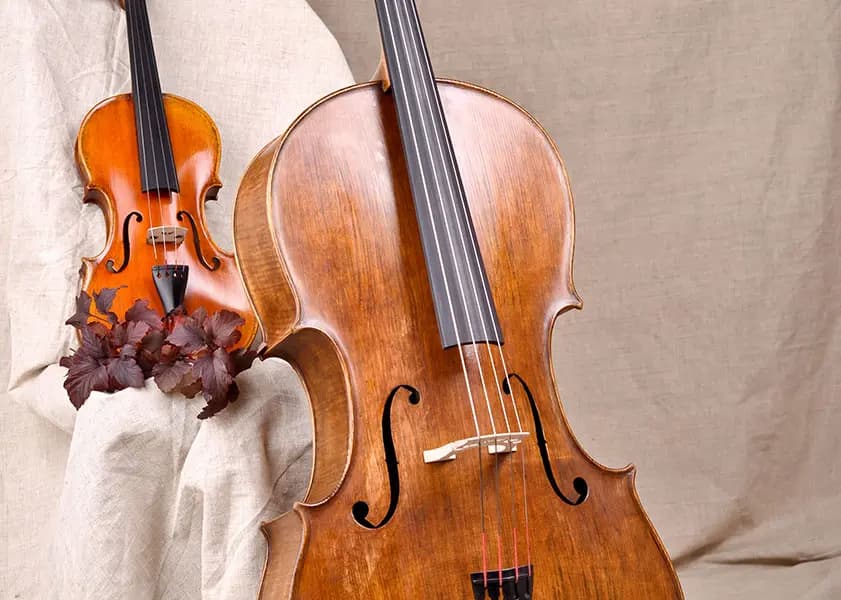The violin and the cello are two of the most beloved members of the string family. Composers, performers, and audiences have adored them both for centuries.

© johnsonstring.com
They share a common shape and ancestry, but each is very different, too, in ways that aren’t immediately obvious at first glance. It can be hard for a beginner to decide which one to pick up!
So help you out (or just satiate your curiosity as a listener), today we’re looking at the distinctive characteristics of the violin and the cello.
Size Affecting Sound
The violin and the cello possess distinct physical attributes that create their sound.
The violin is smaller and has shorter strings, so it has a higher pitch range. It produces a bright, brilliant sound that can be both delicate and virtuosic.
Meanwhile, the cello, with its larger size, emanates a warm, resonant timbre. It’s deeper and more resonant.
Play violin if: You like higher, brighter notes
Play cello if: You like lower, darker notes
Johann Halvorsen – Duo for Violin and Cello
Sound Affecting Music
Because of their shorter strings and higher pitch, violins excel at a repertoire that is fast and agile. It is comparatively easy to pepper in virtuosic displays and intricate ornamentations.
The cello’s longer, thicker strings give the instrument a deeper tone, making it a favorite with composers and audiences who enjoy melancholic or introspective music.
Play violin if: You like the idea of playing fancy quicksilver notes — and lots of them
Play cello if: You like longer, lower notes
Violin & Cello Duo – Pachelbel Canon in D /AKG 220
Roles in Musical Ensembles
The violin and the cello play important roles in orchestras and chamber ensembles.
The violin section is almost always the biggest in an orchestra. Because of violins’ range (similar to a soprano’s) and their resulting ability to pierce through orchestral texture, they are often used to play a work’s melodies.
The violin section as a whole is usually split into first violin and second violin sections, and the first violins get the melody a lot.
On the other hand, the cello section provides depth and a solid harmonic foundation, creating a rich bass for the melody to rest on top of.
When it comes to chamber music, similar roles exist. Just like in orchestra, the violin often takes the lead and performs melodies. Meanwhile, the cello provides gorgeous support and harmonic richness.
Play violin if: You like being in the spotlight and playing melodies
Play cello if: You like behind-the-scenes work and dislike being the center of attention
Tchaikovsky: Serenade for Strings – Concertgebouw Kamerorkest / Chamber Orchestra
Sitting vs. Standing
When practicing at home, violinists tend to play their instruments standing up. Players hold violins under their chin, resting on their shoulders, and have to learn how to keep the instrument from slipping off their collarbone or dipping down toward the floor. (A droopy violin makes it harder for the bow to be drawn efficiently.)
However, when playing in an orchestra or chamber ensemble, a violinist will usually sit. So make sure you’re comfortable playing in both positions.
Meanwhile, cellists sit to play. Cellos have something called an endpin built into them. An endpin is a kind of built-in spike that extends out from the bottom of the instrument. When not in use, it is unscrewed and slid into storage in the hollow of the instrument.
An endpin means a player doesn’t need to hold up a cello between their legs. They do, however, have to figure out how to work with gravity to keep their bow playing at the right point on strings that are more vertical than horizontal.
Play violin if: You like choosing whether to sit down or stand up
Play cello if: You like sitting down while you play
Bach: Brandenburg Concerto No. 3 in G Major BWV 1048
String Differences
Violin strings are quite easy for fingers to stop. The strings are small and don’t vibrate much from side to side. Players will build up callouses on their fingertips, but they’re painless and don’t show. That isn’t to say you won’t need to fight tension when it comes to stopping violin strings – you will – but you’ll be dropping your fingers onto a largely horizontal string with a big assist from gravity.
On the other hand, cello strings are longer and much thicker, and they vibrate more. They can take more energy and strength to stop. And when you do, you’re not being helped by gravity in the motion quite as much as violin players are.
It’s also worth noting that, due to size, cello strings are more expensive than violin strings. Budget accordingly!
Play violin if: you’re willing to learn the secrets of working with tiny strings
Play cello if: you’re more attracted to stopping big, resonant strings
Strings – Violin, Viola, Cello, Bass
Price
Cellos themselves tend to be more expensive than comparable violins. Sometimes by a lot.
And when it comes to comparable violin and cello cases, the cello case will be more expensive, simply because it’s so much larger.
Hey, at least you’re not paying for a double bass!
Play violin if: you want to lust over instruments that are 100x what you can afford
Play cello if: you want to lust over instruments that are 150x what you can afford
Can You Hear the Difference Between One Million Dollar & $5000 Cello? | Bach Cello Suite No. 1
Bow Lengths
They may look the same at first glance, but violin bows and cello bows are two different things. A violin bow is longer and lighter, and easier to finesse. Cello bows are shorter and heavier, built to draw out sound from thicker strings.
Some violin teachers, when they’re faced with a student who won’t use the entire length of their bow, actually give their students cello bows temporarily as a tongue-in-cheek demonstration of how every inch of a violin bow makes a difference. The cello bows are always so unwieldy for a violin that by the time the student returns to a violin bow, they’re inevitably desperate to use the whole thing!
Play violin if: you want to learn how to work with a longer bow
Play cello if: you want to learn how to work with a heavier bow



